The Story Of The Growth Of The
Description
This section is from the book "The Wonder Book Of Knowledge", by Henry Chase. Also available from Amazon: Wonder Book of Knowledge.
The Story Of The Growth Of The
Motor Truck* and commercial vehicles, as reported by the various states, was 48,000 - about one month's production today of one well-known pleasure-car maker.
While exact dates are not easily obtainable, it is thought to be quite within the bounds of reasonable accuracy to say that the motor truck only began to be recognized as a practical vehicle for commercial purposes in 1905.
Today motor vehicles, both pleasure and commercial, are such a common sight in every city and town, and even throughout the rural districts, that one can scarcely believe that they were a novelty such a little time ago.
The statistics show, however, that in 1906 the total registrations of both pleasure
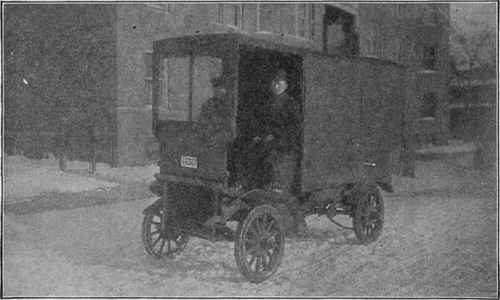
One of the Earliest Gasoline Trucks.
In 1915 the registrations totaled nearly 2,500,000, and every day has added to the number.
It can be truthfully said that the pleasure car is the father of the truck or Commercial car.
The application of the internal combustion engine to the use of propelling vehicles was the beginning of a new era in that world. The idea, born, one might say, with the new century, has already done more to revolutionize transportation than all of the inventions of all the centuries that have gone before.
The automobile, first looked upon as a freak, then "a rich man's plavthing.
*Illustrations by courtesy of the General Motors Truck Co.
has in a few years come to be recognized as a necessity, and literally millions of people are employed in its production and dependent on the industry for support.
To trace the ramifications of the industry back through the mills, mines and factories that produce the iron, steel, copper, brass, zinc, aluminum, lead, leather, lumber, glass, celluloid, etc., would make a long and interesting story, but this chapter deals with the motor vehicle as a commercial car or truck and the part it is playing in transportation of the world's goods.
While the first commercial vehicles to come into use were electrically propelled, and while the electric truck has become a factor in the large cities, the gasoline power vehicles are, as yet, the dominant factor.
At the first, business men were slow to take up the use of trucks for delivery and hauling purposes and one of the specialties of early factories was the making of
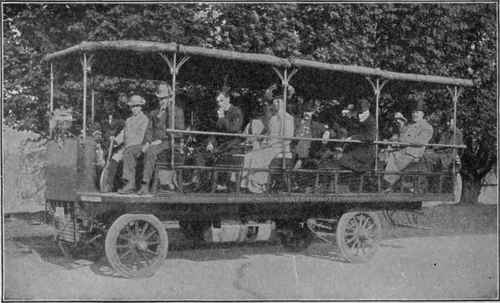
A 1907 Model Sightseeing Car.
"sight-seeing" cars which were sold to enterprising individuals in cities and summer resorts for the purpose of showing visitors the sights. These wagons became popular throughout the country and are still being used in many places.
Little by little, however, progressive business men saw the advantages to be gained by motor delivery and the motor truck began to gain favor. Several of the pleasure-car manufacturers took advantage of the awakening interest and added a commercial vehicle section to their plants.
Others began to see visions of the day when horses would no longer be used for other than strictly farm work, and motor-truck factories sprang up here and there, even faster than pleasure-car plants.
Like the seed mentioned in the parable of the sower, some fell on good ground and grew to produce a bountiful harvest, but many withered by the wayside.
In the early days of the motor-truck industry men bought the finished vehicle, but later on the practice of selling chasses only became popular, and while today some manufacturers cater to the body trade, a large percentage of trucks are sold
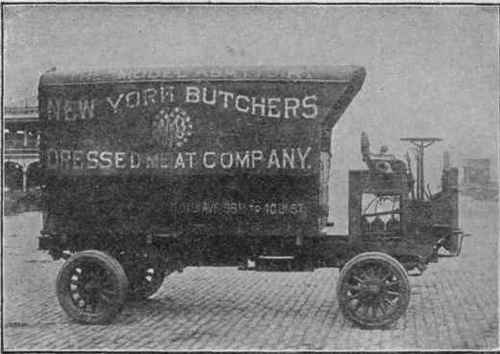
Reliance Truck - 1908.

1908 Truck Model
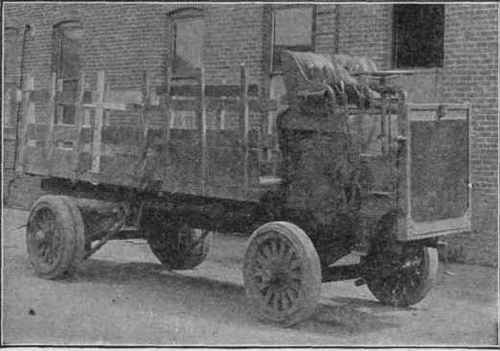
Reliance Truck - 1909.
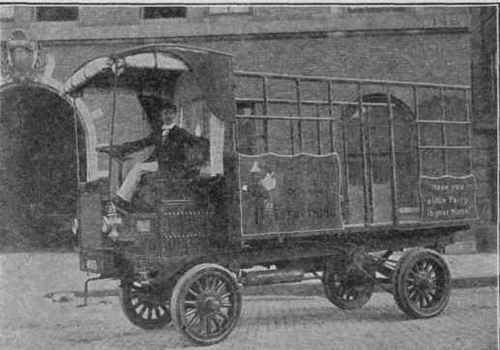
1909 Truck Model to the purchaser without the body, this being built by a local builder, the truck manufacturer furnishing a body builder's blue-print.
As in everything else, it has taken time to overcome the faults of the early trucks.
Most all trucks above 1,500 pounds capacity are equipped with solid rubber tires, and while the solid rubber tires and the springs on the trucks give a great deal of resiliency, it was discovered that the steady pounding over all kinds of pavements soon racked a truck to pieces and that pleasure-car practice could not be followed successively in building motor trucks.
In the earlier days truck buyers made many mistakes in selecting the size or capacity of trucks. Some made the mistake of buying trucks too light for their work. Others selected trucks large enough to provide for exceptional or emergency loads, and would, for example, buy a truck of 33 1/2-tons capacity when 90 per cent of their hauling was loads not exceeding 11/2 or 2 tons. Thus they not only had a greater investment than necessary in the truck itself, but were paying an exclusive charge in the way of operating costs and depreciation.
But the experimental days have passed, both in the manufacture of motor trucks
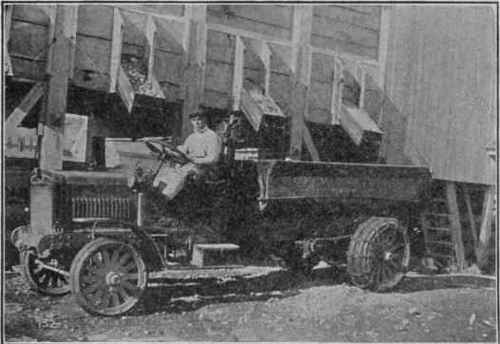
5-Ton Truck - 1913-14
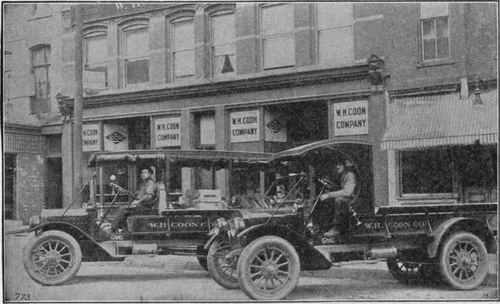
Latest 3/4-Ton Model.
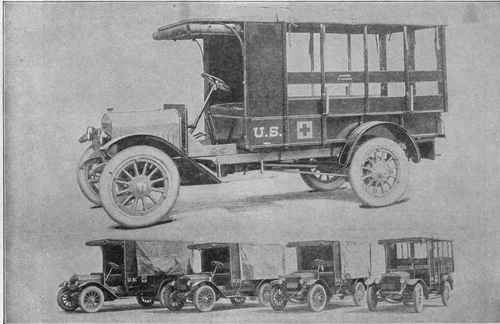
Some 3/4-Ton Trucks of the Latest Model.
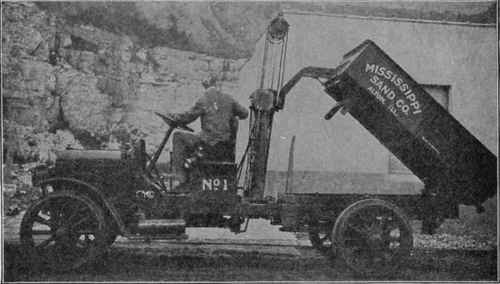
A 1 1/2-TON Truck of the Latest Model Dumping.
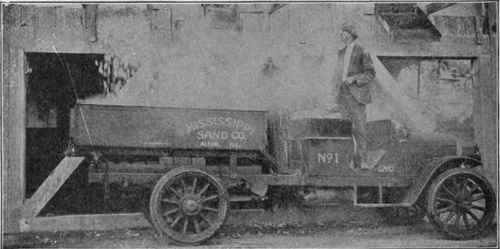
A 1J4-Ton Truck of the Latest Model Loading.

Rear End Construction of a Modern 5-Ton Truck.
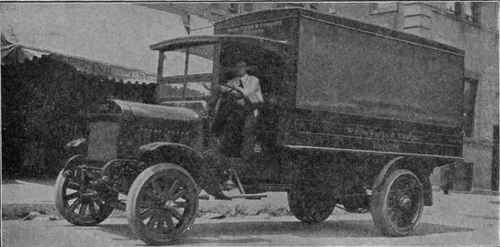
A 3 1/2- Ton Truck of the Latest Model in Active Service.
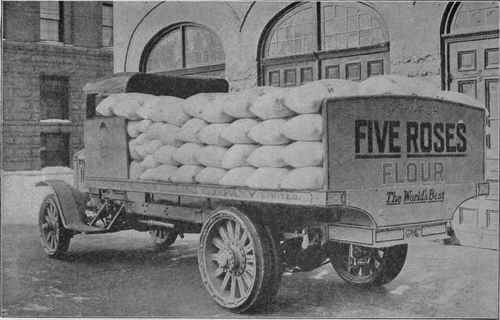
The Latest 31/2-Ton Truck Doing Duty.
and in their adaption to various lines of work. If the buyer has not determined by experience and investigation the kind and capacity of truck he should use, the older manufacturers are able to step in and analyze the work to be done and to intelligently recommend to the buyer what he should have.
That motor trucks not only furnish cheaper transportation than horse-drawn vehicles, but greatly extend the radius of operation, is quite generally conceded. This is shown by the enormous increase in the demand for motor trucks in all lines of business where goods of any kind are to be moved over any considerable distance.
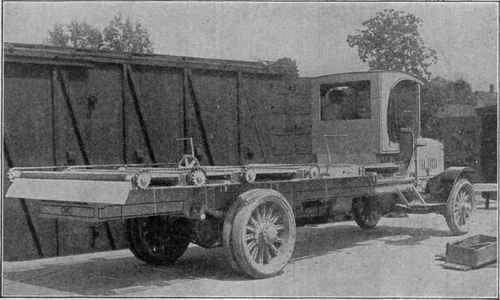
Chassis of the Latest Model 334-Ton Truck.
With motor trucks, merchants have extended their deliveries to reach territory they could not touch under the horse-delivery system.
Market gardeners, who must have their product in the city markets early and have it fresh, can now sell their high-priced land adjoining the cities and go miles back in the country where as good ground can be bought for from one-tenth to one-fourth the price their suburban property will bring - and still be closer to market with their motor trucks than they were before with their horses.
Contractors can transport material long distances and save both time and money. Dairymen collect milk over a radius of thirty or forty miles and get it to market fresh. Freight and passenger lines are possible with motor trucks where a steam railroad or trolley system would not be practicable.
In short, the motor truck is revolutionizing transportation. As made today by the leading manufacturers, it is simple, durable and easy to operate and care for.
Continue to:


